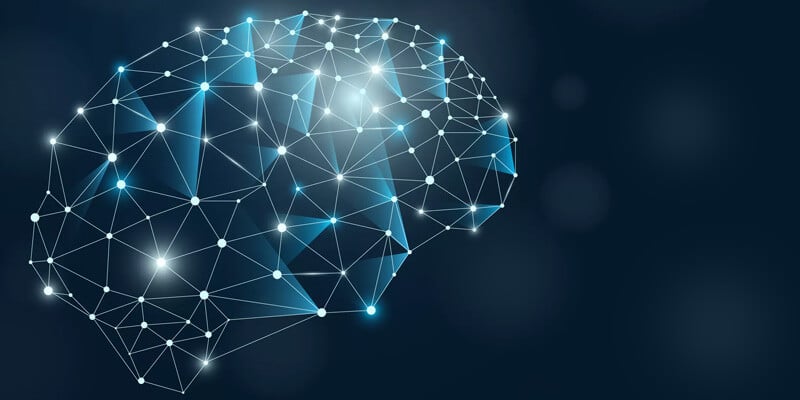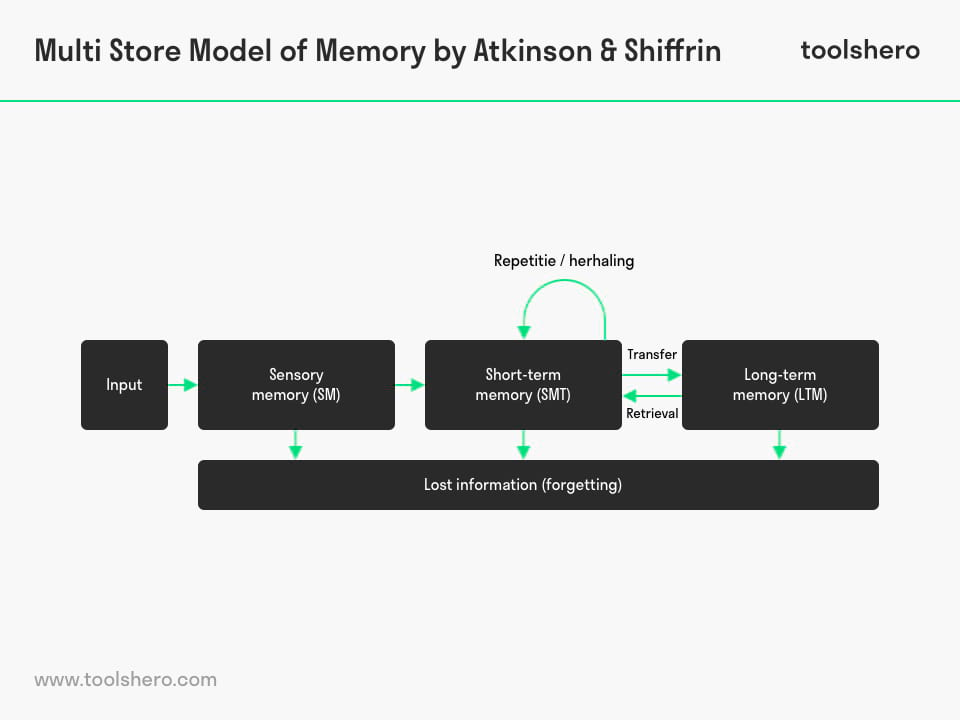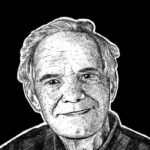Modal Model of Memory (Atkinson and Shiffrin)

Modal Model of Memory: this article explains the Modal Model of Memory, developed by Richard Atkinson and Richard Shiffrin in a practical way. Next to what it is, this article also highlights what is memory, the three stages of memory, retrieving Stored Information and a short summary. Enjoy reading!
What is the Modal Model of Memory (Atkinson and Shiffrin)?
The Modal Model of Memory, also known as the Multi Store Model of Memory, is a theory that was developed by Richard Atkinson and Richard Shiffrin in 1968.
The Modal Model of Memory explains how memory processes work. Despite the fact that the idea of various levels of memory storage wasn’t new, the multiple model, consisting of three parts, was first described by the two Richards.
William James described a primary and secondary memory in the latter years of the nineteenth century. In his theory, primary memory consisted of thoughts that were stored in consciousness for a brief time and secondary memory consisted of permanent, subconscious storage.
Later, Richard Atkinson and Richard Shiffrin added a third level to this theory: the sensory register of the brain. They also came up with the idea that the brain has various control processes that regulate the transfer of memory.
A valuable aspect of the Modal Model of Memory is that it’s supported by scientific evidence, something that’s fairly difficult in theories regarding something as abstract as memory.
In an attempt to cure severe epilepsy, part of a patient’s hippocampus was removed. This led to the problem of this person being unable to transfer information from his short-term memory to his long-term memory.
In other words, the patient was incapable of creating long-term memories. This person was living proof of the idea that there are multiple levels of memory.
What is Memory?
Human memory is the capacity to encode information and experiences in the brain. These codes are subsequently stored and can be retrieved at a later time. This offers human beings the possibility to learn, adapt and build relationships.
In more neurological terms, memory is a series of encoded neural connections in the brain. It is the recreation of past experiences which is brought about by the synchronised firing of neurons that were involved in the original experience.
The experiences aren’t stored as books on a bookshelf, like a complete element, but rather consist of separate elements that are scattered across the various brain areas.
The term memory is also used to describe computers’ capacity to store information. Although there are some parallels between the computer memory and human memory, there are also some fundamental and crucial differences.
The human brain is organised like a distributed network in which each brain cell has thousands of connections. Computer memory consists of a collection of addressable and discrete files.

Figure 1 – Multi store model of memory (Atkinson and Shiffrin)
The Modal Model of Memory: what are the three stages of memory
After information has entered the brain via all kinds of impulses, it must be stored, maintained or removed. Many psychologists use the three-step model of Richard Atkinson and Richard Shiffrin to describe the storage process. For each memory system, the capacity, type of storage and duration are described.
Sensory Memory
Sensory memory stores information for only a moment. For example, when seeing a quickly circling flashlight in a dark space, people see a circle of light rather than separate dots of light.
This is because sensory memory briefly retains these images that quickly follow each other, which means the brain sees a circle via the retina.
Visual sensory memory is referred to as iconic memory, and auditory sensory memory is called echoic memory.
- Storage duration: 0.25-0.5 seconds
- Capacity: all sensory information, large capacity
- Coding: visual, auditory
Short-term Memory
A small part of the information that enters the brain via the sensory part of the brain is transferred to short-term memory. Here, it can be stored for about 18 seconds with a capacity of 7-8 items.
Rehearsal or an intense event can lead to the information being sent to long-term memory, such as repeating a new phone number. The items can be large or small, depending on the individual.
Where one item could be a series of ten numbers for one person, another item could be a single letter for someone else.
When information has already previously entered the short-term memory, and small pieces of this information have been retained, the brain is capable of responding to these stimuli faster or to remember these more easily. This is referred to as priming.
- Storage duration: 0-18 seconds
- Capacity: 7-8 items
- Encoding: mainly auditory information
Long-term Memory
Information from short-term memory can be transferred to long-term memory by means of rehearsal, and back again to short-term memory.
Long-term memory has a practical infinite capacity, which showcases the brain’s enormous potential. When the information is stored in long-term memory, it usually remains there for the rest of a person’s life. However, this doesn’t mean that this person is always able to remember the specific information. The right neurons must make the right connections to retrieve the right memories.
- Storage duration: unlimited
- Capacity: unlimited
- Encoding: mainly semantic (facts, general memory), but also visual and auditory
How To Remember Everything With Tom Weber.
Learn how to remember names, dates, presentations, speeches and anything else that holds importance in your life!
Retrieving Stored Information
Retrieving or remembering is the processes in which information from memory is recalled. Retrieving memories occurs by means of certain stimuli, also referred to as cues.
These cues include associations, context and mood. These three components greatly influence people’s ability to retrieve the right memories.
Associations play an important role in this process. It is possible that deep-rooted memories suddenly resurface upon seeing a certain photograph, smelling a certain scent or hearing a specific sound.
People can sometimes retrieve an event by envisioning themselves in the situation in which this event took place. A frequently asked question when losing your car key is: ‘what did you do right after parking the car?’.
A person’s mood also directly influences one’s capability to retrieve memories. When a person’s mood is the same as it was in the situation concerned, the neurons in the brain make the right connections more easily.
That the information in long-term memory isn’t permanently lost is confirmed by the fact that people can remember specific information when they’re under hypnosis.
Hypnosis makes it easier for the brain to provide the right cues without irrelevant associations getting in the way. The individual is better able to envision the context and his/her mood is largely ignored.
Modal Model of Memory summary
The Modal Model of Memory is a structural model that was developed by Richard Atkinson and Richard Shiffrin. It describes three storage systems that are linearly connected and is described as a model for information processing.
Information can be detected by the senses and enters sensory memory. This is fully automatic, but when certain information is emphasised, it is transferred to short-term memory.
The Modal Model of Memory describes that, in case of sufficient rehearsal, information can be transferred to long-term memory, where it is stored forever. Whether an individual can retrieve this information, however, depends on the associations that are made, or whether the mood is comparable and whether the context in which the events took place shows similarities with the present situation.
Now it is your turn
What do you think? Are you familiar with the explanation about the Modal Model of Memory? What do you believe are factors that contribute to retrieving certain memories or how do you think you can train memory? Do you have anything to add or any remarks?
Share your experience and knowledge in the comments box below.
More information
- Pavlov, I., Watson, J., Skinner, B. F., Thorndike, E., Bandura, A., Maslow, A., … & Treisman, A. Multi Store Model of Memory.
- Atkinson, R. C., & Shiffrin, R. M. (1968). Human memory: A proposed system and its control processes. In Psychology of learning and motivation (Vol. 2, pp. 89-195). Academic Press.
- Tulving, E., & Schacter, D. L. (1990). Priming and human memory systems. Science, 247(4940), 301-306.
How to cite this article:
Janse, B. (2018). Modal Model of Memory (Atkinson and Shiffrin). Retrieved [insert date] from Toolshero: https://www.toolshero.com/personal-development/modal-model-of-memory/
Original publication date: 10/31/2018 | Last update: 12/17/2023
Add a link to this page on your website:
<a href=”https://www.toolshero.com/personal-development/modal-model-of-memory/”>Toolshero: Modal Model of Memory (Atkinson and Shiffrin)</a>












